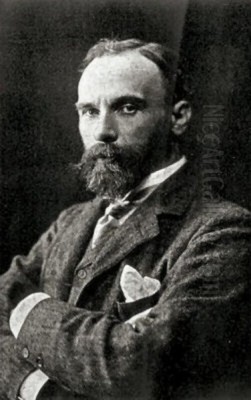
John William Waterhouse stands as one of the most captivating figures in late Victorian British art. Born in Rome on April 6, 1849, to English parents who were themselves painters, William and Isabella Waterhouse, he was immersed in an artistic environment from his earliest days. Though associated with the Pre-Raphaelite Brotherhood, he was active decades after the group's initial formation, inheriting their spirit while forging his own distinct path. His work masterfully blends classical themes, romantic sensibilities, and a unique, painterly technique, creating enduring images, particularly of compelling female figures drawn from myth and literature. Waterhouse passed away in London on February 10, 1917, leaving behind a rich legacy of over 200 works that continue to fascinate viewers today.
Roman Birth and Early Artistic Formation
Waterhouse's birth in Rome was not merely incidental; the city's classical ruins and artistic heritage likely left an impression, even though the family moved back to England when he was about five years old, settling in South Kensington, London. Growing up in an artistic household, he initially assisted in his father's studio, gaining foundational skills in both painting and sculpture. This early exposure provided a practical grounding that complemented his later formal education.
In 1870, Waterhouse enrolled in the prestigious Royal Academy Schools. Interestingly, his initial focus was on sculpture, but he soon gravitated towards painting. His training at the Academy occurred during a period when classical subjects and a high degree of finish were highly valued, championed by leading figures like the President of the Royal Academy, Frederic Leighton, and the immensely popular painter of classical antiquity, Lawrence Alma-Tadema. Their influence is discernible in Waterhouse's early works, which often featured classical or historical genre scenes executed with academic precision.
His debut at the Royal Academy's renowned Summer Exhibition came in 1874 with the classically inspired painting Sleep and His Half-Brother Death. This work, depicting the mythological figures Hypnos and Thanatos, demonstrated his technical skill and his alignment with the prevailing academic tastes. It was well-received and marked the beginning of a long and successful exhibiting career at the Academy, positioning him as a promising talent within the British art establishment.
The Pre-Raphaelite Echo and Romantic Spirit
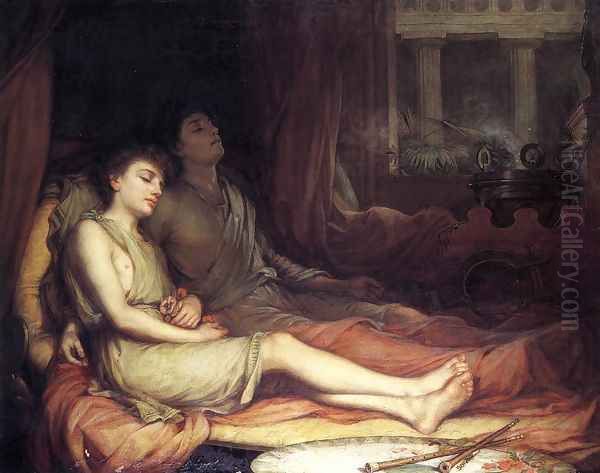
While Waterhouse received a traditional academic training, his artistic soul resonated deeply with the ideals of the Pre-Raphaelite Brotherhood (PRB), founded decades earlier by artists like Dante Gabriel Rossetti, John Everett Millais, and William Holman Hunt. Though not a member himself, Waterhouse is often categorized as a later exponent of the Pre-Raphaelite style or spirit. He shared their fascination with medieval legends, classical myths, and literary themes, particularly those offering dramatic or emotionally charged narratives.
Like the Pre-Raphaelites, Waterhouse emphasized detailed observation and vibrant colour, although his brushwork often became looser and more expressive than that of the original PRB members. He was particularly drawn to their depiction of intense emotion and their focus on female beauty, often tinged with melancholy or tragedy. The influence of second-generation Pre-Raphaelite figures, such as Edward Burne-Jones, with his dreamy, languid figures and mythological subjects, is also evident in Waterhouse's mature style.
Waterhouse successfully synthesized the detailed naturalism and literary focus of the Pre-Raphaelites with the classical compositions learned at the Academy and a broader Romantic sensibility. His paintings evoke mood and atmosphere, often transporting the viewer to otherworldly realms of magic, myth, and doomed romance. He selected subjects that allowed for the exploration of complex emotional states, particularly those experienced by his female protagonists.
Mythology and Legend: The Heart of Waterhouse's Art
The core of Waterhouse's oeuvre lies in his exploration of classical mythology and British legends, particularly Arthurian tales. These subjects provided fertile ground for his imagination and allowed him to depict dramatic narratives filled with beauty, passion, magic, and often, peril. The Victorian era saw a resurgence of interest in these ancient stories, viewed through the lens of contemporary morals, anxieties, and ideals, particularly concerning gender roles and female power.
Waterhouse excelled at choosing moments of high drama or poignant reflection within these narratives. He didn't merely illustrate the stories; he interpreted them, imbuing his figures with psychological depth and placing them in meticulously rendered, atmospheric settings. His depictions often focused on the interactions between mortals and supernatural beings – nymphs, sorceresses, sirens – blurring the lines between the real and the magical.
His fascination extended from the well-known tales of Greek heroes and gods to more obscure figures and moments. He repeatedly returned to certain themes and characters, exploring different facets of their stories. This deep engagement with mythology and legend allowed him to create a cohesive body of work that, while rooted in tradition, felt fresh and deeply personal. His ability to make these ancient tales relevant and emotionally resonant for a Victorian audience was a key element of his success.
Iconic Works: The Lady of Shalott
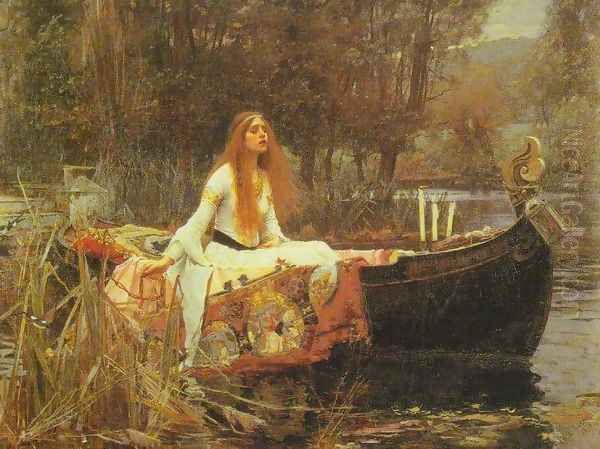
Perhaps no single work better encapsulates Waterhouse's artistic vision than The Lady of Shalott. Inspired by Alfred, Lord Tennyson's immensely popular poem of the same name, Waterhouse painted three versions of this subject (1888, 1894, 1915), with the 1888 version, now in Tate Britain, being the most famous. The painting depicts the tragic heroine from Arthurian legend, cursed to view the world only through a mirror's reflection, as she breaks the curse to look directly at Sir Lancelot and drifts down the river towards Camelot and her death.
The 1888 painting is a masterpiece of mood and detail. The Lady sits in her boat, her tapestry trailing in the water, her expression a mixture of resignation and fateful determination. The surrounding landscape is rendered with Pre-Raphaelite attention to natural detail, yet the overall atmosphere is one of haunting melancholy and romantic doom. Waterhouse captures the precise moment described in Tennyson's poem when she loosens the chain and begins her final journey.
This painting cemented Waterhouse's reputation as a leading painter of literary and romantic themes. It perfectly combined narrative clarity, emotional depth, and exquisite technique. The subject of a beautiful woman facing a tragic fate, drawn from beloved literature, resonated strongly with Victorian audiences. The enduring popularity of The Lady of Shalott speaks to Waterhouse's skill in creating powerful, archetypal images that transcend their specific narrative origins.
Iconic Works: Ophelia and the Tragic Heroine
Another recurring figure in Waterhouse's work is Ophelia, the tragic heroine from Shakespeare's Hamlet. Like The Lady of Shalott, Ophelia represented a potent symbol for the Victorians – a beautiful young woman driven to madness and death by love and betrayal. Waterhouse painted several versions of Ophelia, notably in 1889, 1894, and 1910, each capturing a different moment or mood related to her demise.
His 1894 version shows Ophelia lying by the stream just before she enters the water, her lap full of flowers, her expression lost and ethereal. The lush, detailed rendering of the riverbank flora recalls the work of John Everett Millais, whose own Ophelia (1851-52) was a landmark Pre-Raphaelite painting. However, Waterhouse brings his own sensibility to the subject, focusing perhaps less on botanical accuracy and more on the psychological state of the character and the overall romantic atmosphere.
Waterhouse's fascination with figures like Ophelia and the Lady of Shalott reflects a broader Victorian preoccupation with the "femme fragile" – the beautiful, sensitive woman overwhelmed by circumstances or her own emotions. Yet, his depictions often avoid simple sentimentality, imbuing his heroines with a quiet dignity and complex inner life. He explored numerous other tragic female figures from myth and legend, creating a gallery of compelling women caught in moments of crisis, enchantment, or sorrow.
Exploring Classical Myths: Sirens, Sorceresses, and Nymphs
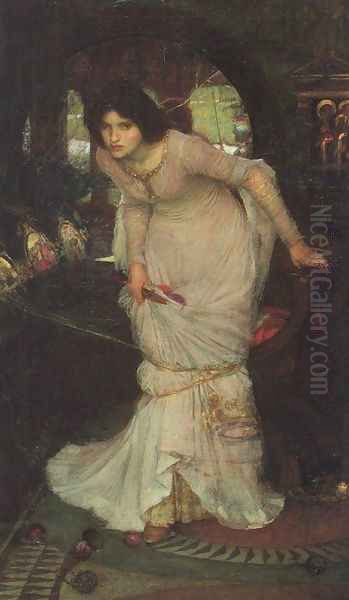
Waterhouse's engagement with classical mythology produced some of his most dramatic and visually stunning works. He was particularly drawn to figures associated with magic, transformation, and dangerous allure. Ulysses and the Sirens (1891) depicts the hero tied to the mast of his ship, resisting the deadly song of the Sirens, whom Waterhouse controversially portrays as bird-like creatures with female heads, a departure from more conventional mermaid-like depictions that sparked debate among critics.
Sorceresses were another favourite theme. Circe Invidiosa (1892) shows the enchantress Circe poisoning the water to turn her rival Scylla into a monster, her malevolent expression and the swirling green poison creating a powerful image of jealousy and dark magic. The Magic Circle (1886) portrays a sorceress casting a spell within a protective circle, the atmosphere thick with mystery and ritual power. These works explore themes of female power, both creative and destructive, often set against exotic or ancient backdrops.
Waterhouse also painted numerous scenes involving nymphs and water spirits. Hylas and the Nymphs (1896) depicts the beautiful youth Hylas being lured to his death by seductive water nymphs. The painting is renowned for its sensual depiction of the nymphs and the palpable sense of danger underlying the tranquil beauty of the scene. Echo and Narcissus (1903) poignantly portrays the unrequited love of the nymph Echo for the self-absorbed Narcissus, capturing the pathos of the myth with delicate sensitivity. These works showcase Waterhouse's ability to blend sensuous beauty with underlying themes of danger, loss, and transformation inherent in the classical myths.
Artistic Technique and Stylistic Evolution
Waterhouse was primarily an oil painter, known for his rich colour palettes and adept handling of light and shadow. His technique evolved throughout his career. Early works show the smooth finish and tight handling typical of academic painting, influenced by figures like Leighton and Alma-Tadema. However, he soon developed a more distinctive style, characterized by looser, more visible brushwork, particularly in backgrounds and drapery, which added texture and vibrancy to his canvases.
He was a master of composition, often using strong diagonal lines or circular arrangements to create dynamic and engaging scenes, as seen in The Magic Circle or The Danaides (1903). His use of colour was both descriptive and emotive, employing deep jewel tones, dramatic contrasts, and subtle harmonies to enhance the mood of his subjects. Light plays a crucial role in his paintings, often used dramatically to highlight figures, create atmosphere, or suggest a supernatural presence.
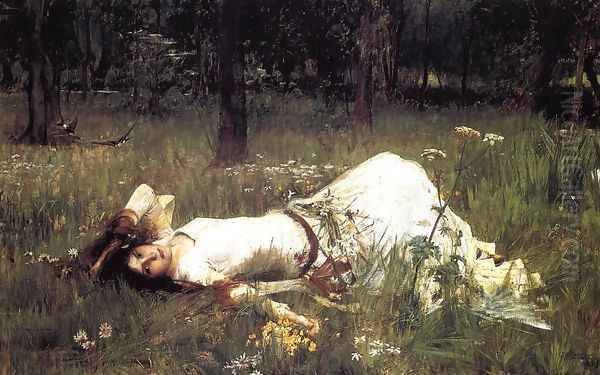
While influenced by the Pre-Raphaelites' attention to detail, Waterhouse's approach was often less intensely focused on minute particulars across the entire canvas. He skillfully balanced areas of high detail, usually the figures and key narrative elements, with more broadly painted passages. Some art historians suggest a possible influence from contemporary French naturalist painters like Jules Bastien-Lepage, particularly in the slightly looser handling and attention to outdoor light effects seen in some of his works, although Waterhouse remained fundamentally rooted in the British narrative tradition.
Waterhouse and the Royal Academy
Throughout his career, Waterhouse maintained a strong relationship with the Royal Academy of Arts. He exhibited there consistently from his debut in 1874 until the year of his death. His talent was recognized relatively early, leading to his election as an Associate of the Royal Academy (ARA) in 1885. This was a significant step, marking him as a prominent figure within the British art world.
His status was further solidified in 1895 when he was elected a full Royal Academician (RA). This honour placed him among the leading artists of his generation, alongside established figures like Sir Edward Poynter (who succeeded Millais as President of the RA) and George Frederic Watts. Waterhouse took his academic duties seriously, serving on the RA Council and participating in its teaching activities.
Despite the rise of modernism in the early 20th century, Waterhouse remained committed to his own style of romantic narrative painting, which continued to find favour at the Academy exhibitions. His works were often popular with the public and acquired by major galleries and collectors. His position within the Academy provided him with a stable platform for exhibiting and selling his work throughout his life, even as artistic tastes began to shift around him.
Later Life, Legacy, and Influence
Waterhouse continued to paint prolifically into his later years, despite suffering from increasing ill health, diagnosed as cancer, towards the end of his life. He remained dedicated to his favoured themes, producing late versions of The Lady of Shalott and Ophelia, as well as exploring new subjects like Penelope and the Suitors (1912) and Tristan and Isolde (1916). His final works, such as the unfinished The Enchanted Garden (c. 1916-1917), show a continued vibrancy and engagement with his craft.
He died in London on February 10, 1917, at the age of 67 and was buried in Kensal Green Cemetery. At the time of his death, his style of painting was increasingly seen as outmoded compared to the burgeoning modernist movements. Consequently, his reputation declined somewhat during the mid-20th century. However, a resurgence of interest in Victorian art from the 1970s onwards led to a reappraisal of his work.

Today, John William Waterhouse is recognized as a major figure in late British Romantic painting. His works are admired for their technical skill, evocative beauty, and compelling storytelling. While direct influence can be debated, his romantic interpretations of myth and legend found echoes in the work of slightly younger artists like Herbert James Draper and Frank Bernard Dicksee, who also specialized in mythological and historical subjects. Waterhouse's paintings remain immensely popular, widely reproduced, and held in major museum collections worldwide, securing his legacy as a unique and enduring voice in British art. Other contemporaries whose work shares thematic or stylistic affinities might include figures like Albert Moore, known for his aesthetic compositions of classically draped women.
Conclusion: A Bridge Between Worlds
John William Waterhouse occupies a unique position in the history of British art. He acted as a bridge between the academic classicism of Leighton and Alma-Tadema, the romantic intensity of the Pre-Raphaelites like Rossetti and Burne-Jones, and a more painterly approach that hinted at contemporary European developments. He synthesized these influences into a highly personal style perfectly suited to his chosen subjects.
His enduring appeal lies in his ability to tap into the timeless power of myth and legend, presenting these ancient stories with emotional resonance and exquisite visual beauty. His depictions of women, in particular – whether sorceresses, nymphs, or tragic heroines – are complex and captivating, reflecting both the ideals and anxieties of the Victorian era while achieving a universal quality. Though working within established traditions, Waterhouse brought his own distinct vision, creating a world filled with romance, magic, and poignant beauty that continues to enchant audiences well over a century after his death. His legacy is that of a master storyteller in paint, a Victorian dreamer whose visions of myth and legend remain vividly alive.